|
BIRDING TRIP REPORT:
South Africa
(north east & south west)
April 2012
By Stephen Burch
Introduction
With a business
trip to Durban, South Africa in April 2012, this was a great
opportunity I could not resist for some birding and
photography afterwards! Making a full week available after
the business part of this trip, I decided to spend about
half my time in the coastal areas north east of Durban which
are semi-tropical and promised to be rich in birds. However,
as I had previously been to Kenya, I was aware that there
could be considerable overlap with species seen there. Hence
for the second half of my stay I opted to fly to Cape Town,
with the main aim of getting on a pelagic out of Simon's
Town to see albatrosses and other sea birds. Also this part
of SA is very different in climate and habitat from that
around Durban, with very little overlap in the avifauna.
This was a self
organised trip - I was not part of any tour group. As I was
on my own, I could make reasonably early starts most days
and then have almost 100% birding/photography thereafter
until dusk each day!
In the event, as
well as the indifferent weather (see below), April is of
course autumn in South Africa, so that most birds were not
singing strongly. Both of these factors I feel limited the
number of species, especially the smaller birds, that I
managed to find (and identify - a non trivial task - more of
which below). Also only briefly at one site (Dlinsa) did I
have the benefit of a local guide. Even this showed that to
maximise species counts, local guides would be a definite
advantage, but that wasn't the main aim of this trip.
General
Flights
For the business
part of this trip, I flew BA from Heathrow to Johannesburg
on the overnight flight and then on to Durban. My experience
on arrival at Johannesburg was not the best - with a 45min
queue for immigration (some others, arriving later in the
day, had much worse experiences with waits up to 2-3
hours!). I then collected my luggage and found my way to the
domestic terminal quite easily (the lifts are on the far
side to your left when you emerge from the international
terminal arrivals into the general concourse). After the NE
leg of my trip, I then took the BA/Comair evening flight
from Durban to Cape Town. My homeward flight was then the
relatively easy but lengthy direct overnight BA flight from
Cape Town to Heathrow.
All these flights were OK and
on time.
Car Hire
I had pre-booked cars for collection at both Durban and
Cape Town airport with Holiday Autos, who have an
arrangement with Europcar in South Africa. Arriving at
Durban airport I was told my reservation had been cancelled
(clearly an error on their part), but fortunately they were
able to reinstate it although there was a delay of 30mins
while they prepared the car. The Cape Town reservation was
fine. Although I re-fuelled both cars close to the airports
on my return, I was surprised to find I was later charged on
my credit card small amounts for fuel at both places (only
about £3 in each case).
Accommodation
I had pre-booked all my accommodation in advance via the
Internet, generally selecting lower priced hotels or bed and
breakfast places. All were fine - for further information
see the end of this report.
Maps
Good large scale maps of SA seem somewhat problematic. The
general maps of the whole of SA are on a tiny scale, so I
purchased in advance the 1:200,000 MapStudio Pocket Map of
Kwazulu-Natal. This was pretty useless. However the
MapStudio 1:325,000 map of the Cape Town area was somewhat
better although covered a much larger area than I needed.
For the first time on a foreign trip, I also had the benefit
of a SatNav which I can highly recommend - this mostly
worked very well - it helped that many of my overnight stops
provided lat, long coordinates for just this purpose.
Birding information
For bird ID, I acquired the 4th edition of the Sasol Birds
of South Africa which seems to be the best for the region.
The South African Birdfinder (also by Sasol) is the bible
for site information, and was quite good.
I'd also like to thank Peter
Barker for the invaluable information and tips he provided
me with in advance based on his own experiences in both
areas. This was a great help in deciding where to go, and
how long to spend in each place. Generally I think my
schedule was about right, but it did involve moving on quite
often - with 5 different places in 9 nights.
Weather
Generally the
weather was considerably poorer than expected, both in the
Durban vicinity and around Cape Town. Only a few days were
warm and sunny and there was a fair amount of rain and cold
conditions (exceptionally so according to the locals in the
Durban area). Strong winds were also a problem, especially
during my last weekend, in Cape Town.
Photos
All the pics shown
below were taken with my DSLR equipment - Canon EOS 7D with
EF400mm/f4 DO lens and x1.4TC, generally on a new monopod.
All pics were taken in RAW format, and I use NeatImage for
noise suppression, with PhotoShop Elements 9 for subsequent
processing. For further details see the equipment and image processing pages elsewhere on this website.
I now describe the main sites
and areas I visited, in approximate chronological order.
St Lucia
St Lucia is a small
tourist town about 2 and a half hours drive north of the new
Durban airport, along the N2 which starts as a dual
carriageway and then progressively deteriorates the further
north you go. There are a number of worthwhile sites in
around the town which I explored over about one and a half
days:
Gwalagwala Trail
This path is quite easy to find on the right of the road
that leads from the town to the estuary mouth/boardwalk,
just past the large KZN wildlife offices on the left. I
walked this trail twice, the first being just after dawn on
my first morning and the second slightly later the next
morning. It is difficult to work out exactly where this
trail is supposed to go, as there are various forks and
branches. At one point it emerges from the shrub/wooded area
to a more open area adjacent to the estuary.
Bird activity was higher on the
first visit, which was in better weather, and without a
guide I found bird identification difficult. I struck upon
the tactic of taking record shots of every bird I could, and
then working out later on my netbook what they were -
usually in the evening after dark! This strategy saved time
in the field, but inevitably I missed several species that I
didn't manage to get photos of.
This trail goes through some
densely vegetated areas with low visibility, but the more
open areas were more productive. The best bird was a Purple-crested
Turaco I managed to photograph out in the open
(they are usually invisible but very vocal - calling loudly
from the middle of dense trees!). There were also both Crowned
and Trumpeter Hornbills. Overhead was an
impressive African Goshawk. Other notables
included the delightful Red-capped Capped Robin
Chat, Barratts Warbler (a bit
like a Cetti's), Crested Guineafowl and White-eared
Barbet. There were plenty of other more obscure
passerines as well, such as Green-backed
Camaroptera. The open area near the estuary has
several species including Collared Sunbirds and
produced a distant view of an African Darter.
Unfortunately I didn't see or hear any sign of Woodwards
Batis, nor the even more impressive Livingstone's Turaco.
I also tried briefly the nearby
boardwalk that runs through to the beach one morning but
this wasn't as productive.
 |
 |
| The splendid Purple-crested
Turaco (click to enlarge) |
White-eared Barbet |
 |
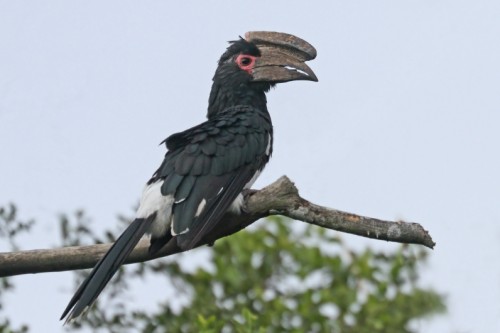 |
| Crowned Hornbill |
Trumpeter Hornbill (click to
enlarge) |
St Lucia Estuary
By far the best way to see the estuary is by a 2hr boat
trip. By great good fortune I was booked by the lodge I was
staying in on a boat 'safari' operated by Heritage Tours
and Safaris.
Unlike most of the other trips, this was on a nice small
boat with only a few other passengers. This allowed a much
closer approach and better photo opportunities than would
have been the case on the far larger boats, which were
packed with passengers. Also this trip was favoured by good,
mostly sunny weather.
The estuary wasn't exactly
teeming with birds, but we did find a good selection. Many
of the larger birds were clearly used to the boats and
weren't bothered by them - allowing a very close approach
(almost too close!) in many cases. The photo opportunities
for the Fish Eagles were superb, with
several birds flying very close to the boat at times. In
addition to the birds shown below, other notables included Spur-winged
Goose, the uncommon Lesser Jacana,
and Malachite Kingfisher as well as
various herons and egrets.
 |
 |
| African Fish Eagle
(click on both to enlarge) |
 |
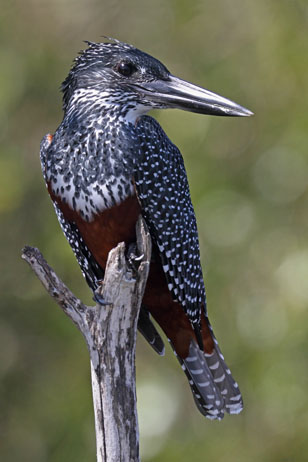 |
| Pied Kingfisher (click to
enlarge) |
Giant Kingfisher (click to
enlarge) |
 |
 |
| Pied Kingfisher |
Hippo (what most of the
tourists want to see, along with some small crocs) |
St Lucia Beach road
A road leads from St Lucia to the estuary mouth where there
is a convenient car park with 'attendants' who clearly
expect some return for watching your vehicle. The road that
runs parallel with the coast leading up to the car park
produced my first sighting of the most impressive Blue-cheeked
Bee Eater - a palearctic species I had been
hoping to see for many years. Also a Brimstone
Canary - a bit like a large brightly coloured
Yellowhammer! In a second visit, the car park had a splendid
collection of these Bee Eaters hawking
for insects from the surrounding trees. On the beach was a White-fronted
Plover and a few Caspian Terns.
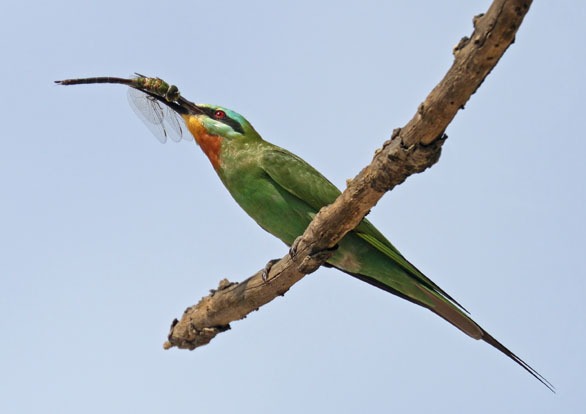 |
 |
| Blue cheeked Bee
Eaters (click left to enlarge) |
 |
 |
| Another Blue cheeked
Bee Eater |
White-fronted Plover |
Cape Vidal road
The road north from St Lucia to Cape Vidal is through a
nature/game reserve with controlled entry - asking for a map
at the entry gate is worthwhile. The terrain on this
pleasant road is quite open, and driving slowly on the side
tracks is recommended, many of which go close to pools.
There were some mammals here, with Water Buck,
Zebra, Water Buffalo and
Kudu (I think). The pools also produced a
good variety of water birds including African
Spoonbill, Jacana, Glossy
Ibis, and Cattle Egret but
nothing exceptional. At one point there was a hide
overlooking a larger area of water, but viewing was hindered
by looking straight into the setting sun. Here there were
more hippos, Hammerkop, Malachite
Kingfisher etc. For smaller birds, I didn't do so
well along this road, but there was an obliging African
Pipit on a track, as well as African
Stonechat etc.
Cape Vidal itself was a big
disappointment. The place was full of campers and I neither
saw nor heard any of the specialities mentioned in the book.
Probably dawn in spring is the time to be here, not late
afternoon in autumn! [This would involve staying overnight
in one of the campsites, as the access road from St Lucia
doesn't open early]. In one spot I found a mixed species
flock but had a very frustrating time trying to get adequate
views to identify them. Photography was for once hopeless as
all the birds were far too skulking.
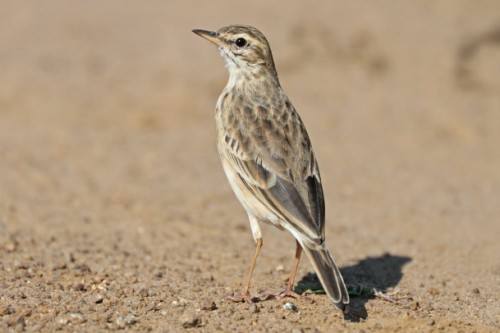 |
 |
| African Pipit (click to
enlarge) |
Malachite Kingfisher |
Hluhluwe Park
Hluhluwe is a 'big
five' game park inland from St Lucia. I approached by the
southern entrance gate at Nyalazi gate which is not the
recommended approach and did involve a reasonable drive
along the R618 which isn't a particularly good road. At the
entrance I saw a White backed Vulture which
was a promising start and then drove north along the
metalled road towards Hilltop camp where I was spending one
night.
In Hluhluwe you are free to
drive around on the unmetalled side tracks as well as the
the main tarmac roads, but you are only supposed to get out
of your car at designated picnic sites. Dangerous predators,
and other big game for that matter, were not plentiful
although I did (almost) bump into several White
Rhino and one small group of Giraffe.
However I saw no elephants, nor predators such as lions
(which were apparently very difficult to find). The high
vegetation in the northern section of this park hampers game
viewing as animals simply vanish if more than a few metres
from the road. From the game perspective, this park did not
compare well with the Kenyan game parks, especially the
Masai Mara, that I had visited in 1986, but of course this
was not the main reason for my brief visit here.
Driving slowly around the
unmetalled tracks seemed the best birding tactic for this
place, for which the map available at the entrance gate was
essential. Over one afternoon and the following morning I
picked up a fair variety of species in this way, including a
close fly past from this magnificent Bateleur. Smaller
birds included a localised Orange Ground Thrush,
Blue Waxbill, Grey Go -away bird, Green Wood Hoopoe,
Red-billed Quelea, Striped Kingfisher and
Crested Barbet.
 |
 |
| Bateleur (click to enlarge) |
Crested Barbet |
 |
 |
| One of three White Rhino
blocking the track! |
Giraffe on the main road |
Hilltop camp
Staying at Hilltop camp, which is situated in a
magnificent location, I was hoping for some good birds in
the grounds - especially from the trail. However in this I
was sadly disappointed - walking this trail just after dawn
on a cold, windy dull morning was not productive, and I
don't think I saw or heard a single bird! The more open
grounds had several invisible Turacos
(presumed Purple Crested) calling loudly and a few Trumpeter
Hornbills, but little else in the cool conditions
that morning. So I departed shortly after breakfast and
found the tracks in the park better, as described above. I
left the park in the early afternoon by the recommended
northern gate which did allow me to get back onto the N2
more quickly than the southern route. There was a Black-shouldered
Kite by the roadside outside the park.
Mtunzini and Umlalazi
The coastal town of
Mtunzini is about 130km north of Durban and within easy
reach of the airport. I stayed here for two nights, the
first of which was badly affected by cold, wet conditions.
Although the rain had cleared by the morning, the cool, damp
conditions were not conducive to bird activity.
Despite this, before breakfast
on my first day, I tried the two locations for Palm Nut
Vulture in Mtunzini described in the Birdfinder book. These
were not productive. The Wilderness drive spot seemed to
have no view at all of palms nor anything else for that
matter, and the views of the coastal forest from the other
location in the town were impossibly distant (if I had the
right place).
Raphia Palm Monument
The Raphia Palm Monument is the site in SA for Palm
Nut Vultures. To reach this area, you need to go
into the middle of the town, and follow the sign to the KZN
wildlife or similar (not very obvious) which is a right turn
off the main road through the town. The Monument itself is
reached along a narrow track to the right, just before the
controlled reserve entrance.
The Birdfinder book stated that
the Palm Nut Vultures can be seen from the
monument, so taking this literally, I drove to the monument,
parked and walked in. This turned out to be a group of palm
trees with a path through the middle with zero visibility.
This clearly wasn't right! Retracing my route, it seemed
that the approach track was more promising. This was between
the road to the reserve and the monument, with reasonable
visibility over open ground to trees on both sides. However
in the cool damp mid morning conditions activity was low,
and there was no sign of vultures or much else for that
matter. It was only when I returned around midday, when it
had brightened up a bit, that I got a view of one in flight
and then perched on top of a tree (as advertised), on the
inland side of the track. This track also had a Fiscal
Flycatcher.
 |
 |
| Woolly necked Stork (click to
enlarge) |
Palm Nut Vulture near the
Raphia Palm Monument |
Umlalazi
Umlalazi is a small reserve, with a controlled
entrance (get a map at the visitor centre). I spent one damp
cool morning here, and picked up quite a few birds drinking
an bathing in the roadside puddles formed from the overnight
rain! These included Red-capped Robin Chat
again, Bronze Manakin and Black-collared
Barbet. Hawking over the reeds were African
Palm Swifts, and skulking in the bushes was a Southern
Brown-throated Weaver. The main campsite had very
approachable Woolly necked Storks (which
were also hanging round the entrance gate area) and a Brown
hooded Kingfisher. Also plenty of calling but
invisible Purple crested Turacos. The
mangrove trail along the lagoon was a waste of time (and
doesn't join up in the middle), but on the far bank was a Goliath
Heron. I didn't try the road that runs parallel
with the shore - perhaps I should have.
 |
 |
| Red-capped Robin Chat on the
road in Umlalazi |
Brown hooded Kingfisher |
Dlinsa/Eshowe
The Dlinsa forest
is about a 40min drive from Umlalazi and I visited it twice.
The first was in the afternoon in largely cool dull
conditions when it was very disappointing, but the second
visit arriving at around 9am the next morning in brighter
warmer weather was much better. For those with a SatNav, the
co-ordinates are S 28° 53.515' E 31° 27.085' - it is through
the town of Eshowe from the main approach road (R66).
The aerial boardwalk was
however something of a disappointment and not quite what I
was expecting. It may be aerial, but it is only about 1m off
the ground - nowhere near the canopy, and the so called
viewpoint gives very restricted views over a bit of distant
canopy. Nothing like the tower at Cristallino Lodge in Brazil! Perhaps it was because it was
autumn, but I'm not sure I saw of heard a single bird on the
boardwalk on both visits!
However the network of paths
through the forest were better for birds, though on my own
they were very confusing and easy to get lost - not a good
idea. It would be much better if they had a map of the
reserve showing the paths clearly. On my second visit I
briefly had the services of bird guide, who almost
immediately put me onto one of the specialities of the area
- a Spotted Ground Thrush. Unfortunately
photography was difficult due to dark forest conditions. I
needed ISO 6400 to get an exposure time of 1/30 sec - almost
stupid to try with only a monopod for support. Also the
bird, though reasonably tame, soon scuttled off, and I never
got a completely clear shot of it. Other birds seen from the
paths included Golden-tailed Woodpecker, Forest
Weaver and Bronze Manakin.
 |
 |
|
Spotted Ground Thrush
|
The best spot by far was the
Bishop's Seat picnic area - reached via one of the paths
(you really need a guide to show you where it is). It is
somewhat more open than the rest of the forest and hence has
better visibility. I spent some time here, and was rewarded
with views of Grey Cuckoo Shrike, Cape
Batis, Greater Double-collared Sunbird,
Olive Sunbird, Olive Woodpecker
and Emerald Cuckoo high up in the canopy.
At one point a Purple crested Turaco flew
across the clearing, and while watching it in the trees I
suddenly noticed a red patch. Sure enough this was a
stonking NARINA TROGON - an ace bird, and
one I didn't expect to see on my own. However to my great
regret the camera was some metres away and of course by the
time I had retrieved it this memorable bird had gone. A
couple who appeared at one point also had a Crowned
Eagle land in a tree, but all I saw of it was an
un-tickable glimpse as it flew off.
 |
 |
| Tawny flanked Prinia |
Emerald Cuckoo |
After my second morning visit
to Dlinsa I then packed up my gear into 'flight mode' and
headed off to the airport for the early evening flight to
Cape Town for the second phase of my trip.
East of Cape Town area
For my first two
nights in the Cape Town area I stayed in Gordon's Bay and
visited a number of sites within easy reach of there, as
described below.
Sir Lowry's Pass
This site was my first priority as it is a site for the
superb Cape Rockjumper. This site was
close to Gordon's Bay so I visited it first thing on day one
of my stay in the area. Fortunately the sun was shining and
the wind wasn't too strong (unlike later in my stay in this
area). Parking in the car park by the busy N2 you then need
to take your life in your hands and get across both lanes of
the busy N2 on a bend - but it wasn't actually too
difficult! However beware Baboons jumping into your car at
this site!
Following the directions in the
Birdfinder book I made my way along the track that runs
parallel to the ridge on the left. Notable birds included Rock
Kestrel, Peregrine, Cape
Rock Thrush, Cape Grassbird and
the extraordinary Cape Sugarbird with its
amazingly long tail. But Cape Rockjumper
was my main priority here, and amazingly a pair appeared
just where the Birdfinder book said they should be - by the
signal cannon that is reached by turning left on a path that
goes over a pass, and then following a tiny track helpfully
marked 'signal cannon'. I first spotted the male on a
distant rock, and was then surprised to have it fly almost
right to my feet where it joined a female. To my great
regret it was then 'only' the female that showed well for
close up photos.
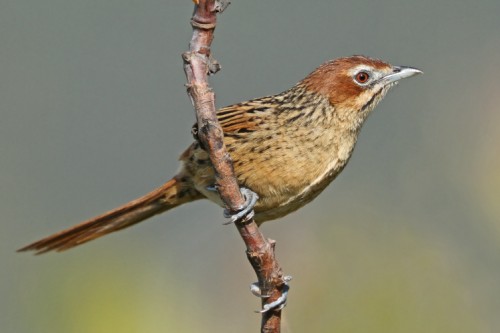 |
 |
| Cape Grassbird (click to
enlarge) |
Cape Sugarbird (click to
enlarge) |
 |
 |
| Cape Rock Thrush |
A magnificent but distant male Cape
Rockjumper |
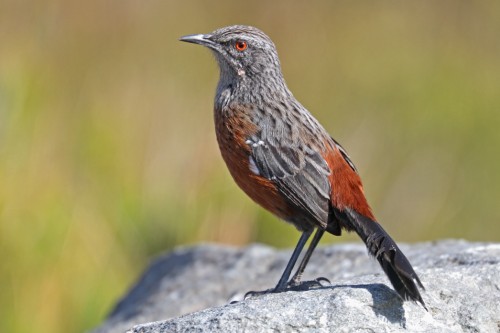 |
 |
| The less impressive
female Rock Jumper (click left to enlarge) |
N2 east to Caledon
Another of my targets in this area was Blue Crane,
and my information suggested these could be seen from the N2
before reaching Caledon. This was indeed the case, and I had
fleeting glimpses of a few small groups of these birds when
travelling at speed on this road which is most unsuitable
for relaxing birding. So I turned north on the R406 before
Caledon and sure enough I soon spotted some more but distant
Blue Cranes. Other notable species on this
much quieter road were Pied Starling, Cape
Crow and Cape Sparrow.
Kleinmond
Kleinmond is on the coast, just east of Betty's Bay. I
followed the signs to the whale viewing point/beach. Here
were some Hartlaub's Gull and also some Hadeda
Ibis just by the road in splendid light. Offshore
were my first Cape Gannets and Cape
Cormorants. Rather more notable was an African
Harrier Hawk over the village as I was leaving.
 |
 |
| Hadeda Ibis (click to enlarge) |
Hartlaub's Gull |

|
African Harrier Hawk
over Kleinmond
|
Stony Point, Betty's
Bay
The Stony Point African Penguin colony is
well signed off the coastal road. There is a controlled
entry (small entrance charge) to the boardwalk that runs
through the colony. This was actually a nicer and less
touristy place than the better known colony at Boulder's
beach near Simon's Town that I visited a couple of days
later (see below). When I arrived at Stony Point in the late
afternoon the sun was still shining, but it soon clouded
over and there was torrential rain (sign of the bad weather
to come) after I left.
In addition very close views of
plenty of cute African Penguins, this site
also had African Sacred Ibis, Little
Egret, Kelp Gull, Swift
Tern, various Cormorants and Black
Oystercatcher. Cape Gannets
were also offshore. As I was leaving, I came across Cape
Bulbul and a nice group of Cape
Spurfowl.
 |
 |
| African Penguin (click to
enlarge) |
Cape Spurfowl |
Harold Porter Botanical
Gardens
These botanical gardens are well signed in Betty's Bay and
close to the other sites mentioned here. My visit here was
on a public holiday and the place quickly became crowded
with noisy people causing most birds to depart! Just after I
arrived it was however quieter and there were several Familiar
Chats hopping around rather like Black Redstarts.
The path up to the small lake produced plenty of Cape
White-eyes and also some Swee Waxbills,
but little else.
 |
| Familiar Chat |
Rooi Els
This site is again well described in the Birdfinder book.
The approach track, just after turning off the main road,
was good for Cape Bunting and Cape
Sugarbird. I walked along the track which runs
below a rocky ridge hoping for more Cape
Rockjumpers but was disappointed. However the
photogenic Orange breasted Sunbirds were
showing well in the sun, and I also found a skulking Karoo
Prinia.

|
 |
| Orange breasted Sunbird (click
to enlarge) |
Cape Sugarbird |
South of Cape Town area
Having spent a
profitable couple of days to the east of Cape Town I then
moved to the south, staying in Boulders Beach to be
conveniently placed for the booking I had with Cape Town
Pelagics for the Saturday or Sunday.
Strandfontein Sewage
Works
These sewage works are said to be in a somewhat unsafe area,
but I didn't feel threatened at all. The coastal R310 road
does go past some shanty towns but it seemed OK staying in
the car and keeping moving. At the site itself, there was a
guy on the entrance recording vehicles going in which
provided some reassurance as well, although there wasn't
much of a barrier and no fee was payable.
Following the directions in the
Birdfinder book (which mentions no hazards at this site), I
proceeded to bird lakes B, C and D. However there was a firm
barrier at the plant buildings further on and I wasn't sure
if entry was permitted beyond it. As I didn't have much time
on both of my visits here I didn't investigate further.
However the readily accessible lakes had quite a few water
birds around including Cape Teal, Red-billed
Teal, Yellow-billed Duck, Cape
Shoveler and Black-necked Grebe.
Overhead were various swifts and hirundines - I managed to
identify African Black Swift and Little
Swift. Also several of "our" Swallows
which seemed surprising as it was well into April. On my
second visit, just before returning to the airport, I had an
African Marsh Harrier and this Purple
Gallinule (or Swamphen).
Passerines included Cape Canary and Common
Waxbill.
Altogether a very easy to site
to bird and photograph from the car.
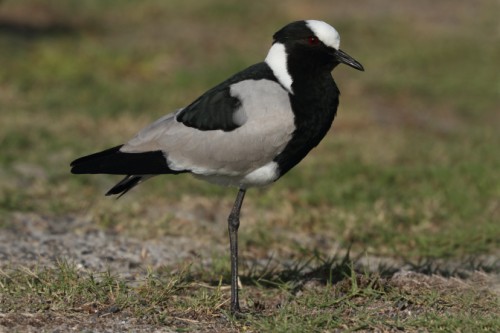 |
 |
| Blacksmith Plover (click to
enlarge) |
Purple Gallinule (Swamphen) |
Boulders Penguin Colony
Boulders is the famous African Penguin colony, as featured
on many nature programmes etc. The access to the small
beach, very close to the Boulders Beach Lodge where I was
staying, involves paying an entry fee. However there were
then no Penguins on view, so I quickly exited this section
and made my a reasonable distance along a tarmac path to the
main boardwalk. The bushes by this path had masses of Cape
White Eyes and a presumed Cape Batis seen briefly, but was
much disturbed in the late afternoon. The boardwalk of
course had plenty of Penguins and people. I think I
preferred the quieter Stony Point reserve.
The Penguins were also nesting
in the grounds of the Boulders Beach Lodge, very close to my
room! They made the presence known by calling well into the
evening and again in the early morning, so a bit of a mixed
blessing!
 |
 |
| African Penguins at
Boulders |
Cape Point NR
I spent the better part of a day at the Cape Point NR in
initially very dull and windy conditions, but as so often
this trip it brightened up a bit later on. I started at the
main car park for Cape Point itself and walked down the
track towards the sea, as suggested by the BirdFinder book.
Here was an obliging Southern double collared
Sunbird and a Cape Grassbird. A
Cape Robin-chat then appeared briefly, but
I couldn't find any Cape Siskins. The standard tourist
funicular up to Cape Point was a definite mistake though.

|

|
| Southern double collared Sunbird
(click to enlarge) |
Cape Grassbird |
The must less visited Cape of
Good Hope was more pleasant and had the added bonus of Ostrich
(including one male) and some roosting Swift Terns
just offshore. The best site was however the road to
Olifantsbos, as mentioned in the book. Along this road I got
a record shot of Jackal Buzzard and White-necked
Raven in the same field of view - two lifers on
one photo can't be bad!
The beach at the end of the
Olifantsbos road had several wary waders - Black
Oystercatcher, Three-banded Plover,
Kittlitz's Plover and White-fronted
Plover. Also plenty of African Sacred
Ibis and the less than spectacular Plain-backed
Pipit. There were several of the unusual looking
Bontebok antelopes around as well, but I
didn't see any other mammals.
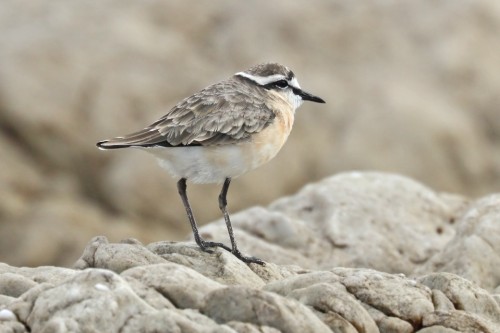 |
 |
| Kittlitz's Plover |
Bontebok |

|
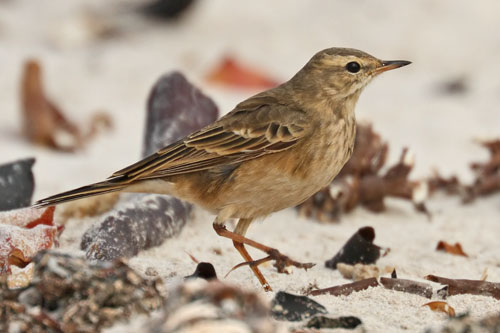
|
Three-banded Plover
|
Plain-backed Pipit
|
Cape Town (non)
Pelagics
Some six months before my visit I booked onto a pelagic with
this company. This was supposed to leave around dawn and not
return until mid afternoon and give once in a lifetime views
of albatrosses, shearwaters and petrels. It was something I
was really looking forward to, and I had arranged this part
of my trip around it. However sadly it was not to be. Just a
week or two before the trip I was told they might have to
cancel due to lack of support. As it turned out this was not
the issue that caused the cancellation - it was the weather!
That weekend it was poor with strong winds, some rain and
overcast skies - clearly not suitable for a tiny boat that
goes many miles offshore. So I had an extra day to
investigate the sites in the area, never expecting to get
something that softened the blow of the cancellation....
Kommetjie
With the pelagic having been cancelled on both its possible
days, on my last day in SA, I wasn't sure where to go. In
the event I decided to try Kommetjie for the Bank
and Crowned Cormorants that had so far
eluded me (I was getting short of ideas!).
Shortly after I arrived at the
beach area I bumped into an English birder from London,
quite by chance, who had a scope. He quickly put me onto my
missing cormorants and then started talking about petrels
offshore that were very distant but present in large
numbers. Without a 'scope I couldn't possibly identify them,
but he reckoned they were White-chinned Petrels.
After that we went our separate ways, but I thought I would
try the promontory with the lighthouse which might give
closer views of the Petrels. It did indeed and I then
noticed that the other birder (never got his name!) was
behind me with his scope scanning around. He suddenly
announced he was onto an ALBATROSS! This
was my first ever Albatross of any species, and very distant
and difficult to make out in binoculars. The birder then set
about working out the ID, concluding it was a SHY
ALBATROSS. These do come quite close inshore
apparently, but I wasn't in a position to confirm or
otherwise the ID - the photo below doesn't really help
either! Later on he picked up a few more, including even
more distant ones that defied any attempts at ID.
So this was some considerable
compensation for the missed pelagic but, as the ultimate
record shot below shows, the views were hardly satisfying.
In fact this has left me still keen to get close up views. Fortunately I was to have another opportunity
for these later in 2012 - for more info click
here!
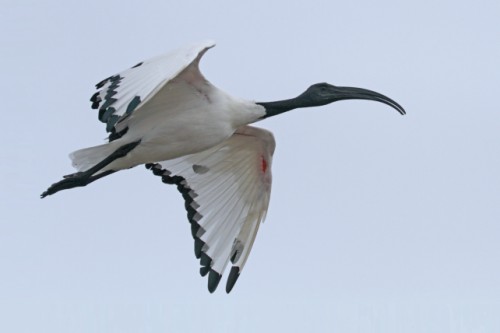 |
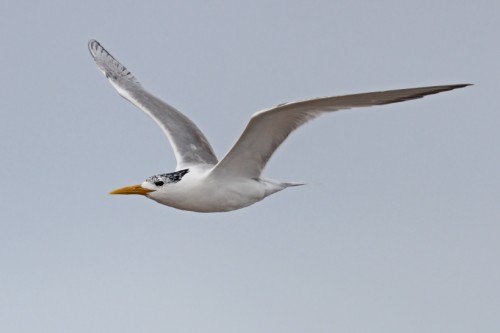 |
| African Sacred Ibis (click
to enlarge) |
Swift Tern |
 |
 |
| Shy Albatross with two White
chinned Petrels (ultimate record shot) |
White chinned Petrel |
Kirstenbosch Botanical
Gardens
Unlike Kommetjie, I had a disappointing visit to these
famous botanical gardens in poor very windy, dull
conditions. This site is reputed to have plenty of
approachable and hence photogenic sunbirds, but not when I
was there! The upper reaches are quite a steep trek up from
the entrance and were being blasted by almost gale force
winds with the result that any birds present were keeping a
low profile. The more sheltered lower parts of the grounds
were a bit better, but only had species I had seen before
such as Southern Double Collared Sunbird,
Helmeted Guineafowl and Cape
Spurfowl. None of the few pics I got here are
worth showing.
Accommodation
Details
| Place |
Comment |
| Seasands
Lodge and Conference Centre, St Lucia |
This was an oldish
rambling place, with my upstairs room some distance
from the main building. The room had a balcony with a
nice view over forest and bats in the roof that
streamed out at dusk! They did however make a bit of a
noise all through the night. Breakfasts were good and
the first night they served an excellent barbeque. The
second night there was no dinner, so I went to the
Ocean Basket on the main road through St Lucia, which
was good. The room was fine but not terribly secure
(no problems though) and the limited grounds were
pleasant but not as birdy as I had hoped. Apparently a
hippo wandered onto the lawn by the main building on
the second evening of my stay, but I was out! |
| Hilltop Camp, Hluhluwe |
The main building was
set on top of a hill with a magnificent view over the
surroundings. Dinner and breakfast were both good. The
rooms were separate and spread out all over the camp.
They didn't lock from the outside which was a bit
strange, and meant having to keep all my optics either
in the car or on me all the time. As mentioned in the
trip report, the birding in the grounds was
disappointing probably due to the season and poor
weather. |
| One
on Hely, Mtunzini |
This modern guest house
had very welcoming and friendly staff. My large
upstairs room had a huge balcony with distant views of
the sea and closer views of the trees in the garden.
Returning one late afternoon I had a nice flock of
Green Pigeons in a tree at the back. Breakfast good,
but make sure you take careful note of the
recommendations for somewhere to eat in the evening to
avoid ending up in the wrong place (as I did on my
first night which was also very wet and cold). |
| Berg
en Zee, Gordons Bay |
Another good guest house
with friendly staff. My huge upstairs room had a
balcony with lovely views of the bay. Good breakfast.
Only slight snag was the number of stairs - as the
place is on a very steep slope. Very conveniently
situated for Sir Lowry's Pass and the other sites in
the area. |
| Boulders
Beach Lodge, nr Simon's Town |
Highlight of this hotel
was the Penguins nesting not more than 5m from my
rather small room (others are apparently even
smaller). The restaurant wasn't very good for dinner
and breakfast was considerably poorer than everywhere
else I had stayed (ridiculous fixed menu). I think
this place was caching in too much on its situation.
It was of course very convenient for the Penguin
colony and the pelagic that never was out of Simon's
Town. Unlike all the other places, I wouldn't
particularly recommend this one. |
© All pictures copyright
Stephen Burch
|